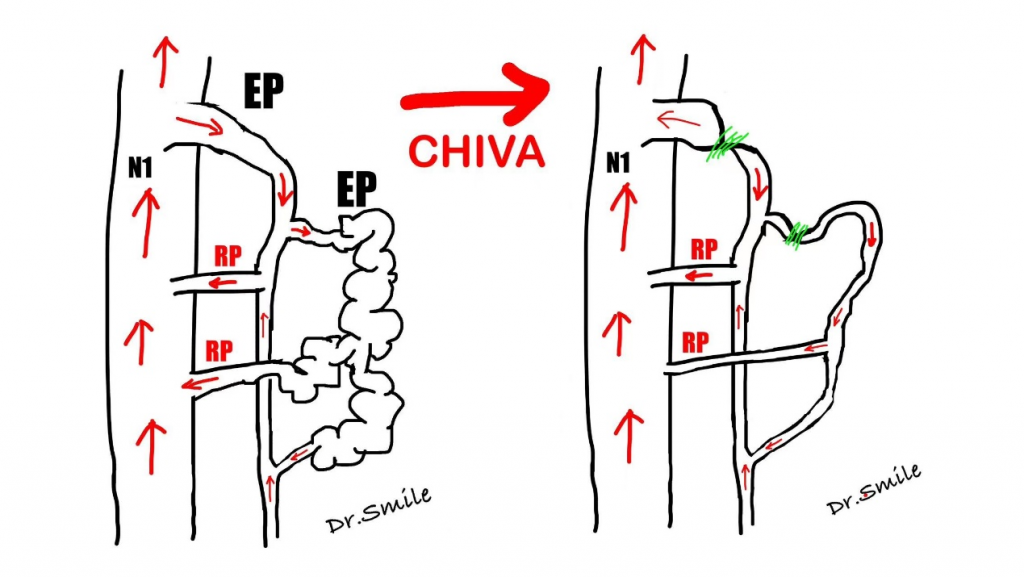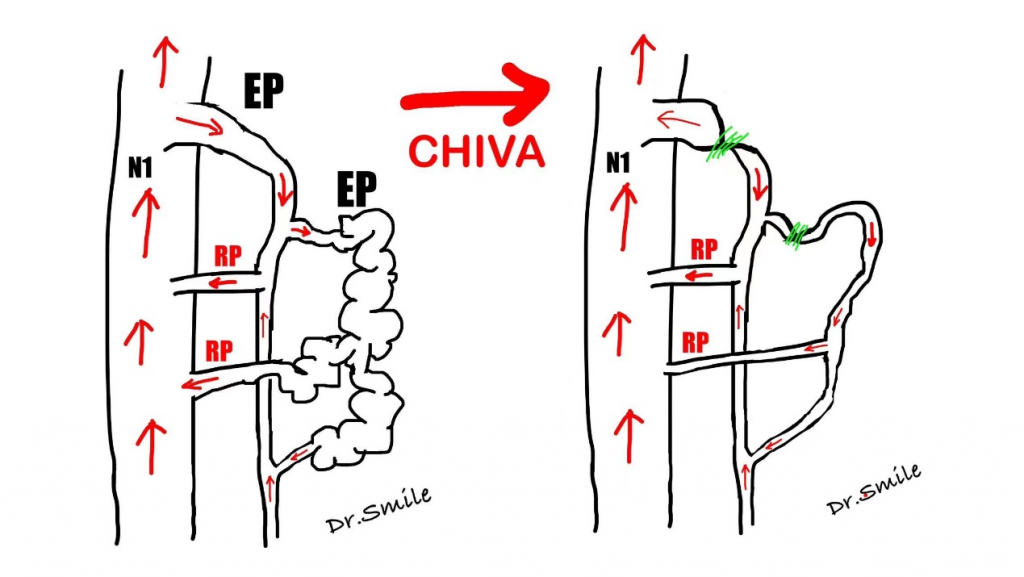首页 > 最新文章 > Health Information
Copyright@VENOUS UPDATE. All Rights Reserved.
Varicose veins are a common condition that affects the quality of life for many individuals. However, a novel treatment method called the CHIVA technique is changing the landscape. Originating from Europe, this minimally invasive treatment concept and technique aim to improve or eliminate varicose veins by restoring normal blood flow within the venous system. This article delves into the principles, efficacy, advantages, limitations, patient experience, and future prospects of the CHIVA technique.
The fundamental principle of the CHIVA technique is to improve varicose veins by restoring normal blood flow instead of simply removing the affected veins. This approach not only resolves the issue but also preserves the veins. The specific steps of the CHIVA technique involve using ultrasound hemodynamic methods to locate the escape point (EP) and then performing minimally invasive surgery under local anesthesia to restore normal drainage.
Past research and clinical practice have demonstrated the effectiveness of the CHIVA technique. In fact, the outcomes and effects of the CHIVA technique in varicose vein treatment are highly significant. Approximately 95% of patients experience noticeable symptom improvement after surgery, and postoperative venous system blood flow function is significantly enhanced. Furthermore, the CHIVA technique can significantly reduce the recurrence rate of varicose veins and the occurrence of surgical complications.
Compared to traditional treatment methods, the CHIVA technique offers advantages such as being minimally invasive, having a shorter recovery period, and providing rapid symptom relief. However, the CHIVA technique also has its limitations. For example, it may not be suitable for all types of varicose veins, requires specialized technical skills and experience, and treatment outcomes can be influenced by individual patient differences.
Clinical cases have shown that the CHIVA technique plays a positive role in improving patients’ quality of life. Most patients provide positive feedback about the CHIVA technique, stating that the recovery period after surgery is short, and their quality of life significantly improves. According to statistics from Dr. Smile Medical Group, they have provided minimally invasive treatment services to over 20,000 patients with lower limb varicose veins. Encouragingly, the patient satisfaction rate exceeded 98.2% in 2021.
Currently, research on the CHIVA technique primarily focuses on further improving its efficacy, reducing recurrence rates, and expanding its indications. With technological advancements and in-depth research, the CHIVA technique has tremendous development potential and may become a mainstream approach for varicose vein treatment.
In conclusion, the CHIVA technique is an effective treatment method for varicose veins that significantly improves symptoms, reduces recurrence rates, and has a shorter recovery period. As research and application of the CHIVA technique continue to progress, its importance in varicose vein treatment grows, and it holds promising prospects. Further research and exploration are warranted to fully understand its potential.
Varicose veins are a common condition that affects the quality of life for many individuals. However, a novel treatment method called the CHIVA technique is changing the landscape. Originating from Europe, this minimally invasive treatment concept and technique aim to improve or eliminate varicose veins by restoring normal blood flow within the venous system. This article delves into the principles, efficacy, advantages, limitations, patient experience, and future prospects of the CHIVA technique.
The fundamental principle of the CHIVA technique is to improve varicose veins by restoring normal blood flow instead of simply removing the affected veins. This approach not only resolves the issue but also preserves the veins. The specific steps of the CHIVA technique involve using ultrasound hemodynamic methods to locate the escape point (EP) and then performing minimally invasive surgery under local anesthesia to restore normal drainage.
Past research and clinical practice have demonstrated the effectiveness of the CHIVA technique. In fact, the outcomes and effects of the CHIVA technique in varicose vein treatment are highly significant. Approximately 95% of patients experience noticeable symptom improvement after surgery, and postoperative venous system blood flow function is significantly enhanced. Furthermore, the CHIVA technique can significantly reduce the recurrence rate of varicose veins and the occurrence of surgical complications.
Compared to traditional treatment methods, the CHIVA technique offers advantages such as being minimally invasive, having a shorter recovery period, and providing rapid symptom relief. However, the CHIVA technique also has its limitations. For example, it may not be suitable for all types of varicose veins, requires specialized technical skills and experience, and treatment outcomes can be influenced by individual patient differences.
Clinical cases have shown that the CHIVA technique plays a positive role in improving patients’ quality of life. Most patients provide positive feedback about the CHIVA technique, stating that the recovery period after surgery is short, and their quality of life significantly improves. According to statistics from Dr. Smile Medical Group, they have provided minimally invasive treatment services to over 20,000 patients with lower limb varicose veins. Encouragingly, the patient satisfaction rate exceeded 98.2% in 2021.
Currently, research on the CHIVA technique primarily focuses on further improving its efficacy, reducing recurrence rates, and expanding its indications. With technological advancements and in-depth research, the CHIVA technique has tremendous development potential and may become a mainstream approach for varicose vein treatment.
In conclusion, the CHIVA technique is an effective treatment method for varicose veins that significantly improves symptoms, reduces recurrence rates, and has a shorter recovery period. As research and application of the CHIVA technique continue to progress, its importance in varicose vein treatment grows, and it holds promising prospects. Further research and exploration are warranted to fully understand its potential.

Dr. Smile Medical Group is the largest chain of vein centers in Asia, founded in 2014 and headquartered in Shanghai. With a presence in 13 cities across China, including Beijing, Guangzhou, and Shanghai, the group has established itself as a pioneer in the use of cutting-edge technology for the diagnosis and treatment of various types of varicose veins. Dr. Smile’s personalized approach includes a hemodynamic assessment and a focus on different types of varicose veins, ensuring that each patient receives customized treatment. The group is also responsible for the CHIVA global certification and training program, demonstrating its dedication to excellence in the field of venous care. With thousands of patients treated every year, Dr. Smile has become a leading authority in the field, and its experts are regularly invited to participate in CME and global venous forums to share their expertise and insights with fellow practitioner.
静脉曲张的CHIVA技术:理论、实践与展望
静脉曲张是一种常见的疾病,影响了许多人的生活质量。然而,一种名为CHIVA技术的新型治疗方法正在改变这一局面。这种源自欧洲的微创治疗概念和技术旨在通过恢复静脉系统的正常血流来改善或消除静脉曲张。本文深入探讨了CHIVA技术的原理、疗效、优势、局限性、患者体验和未来前景。
CHIVA技术的基本原理是通过恢复正常血流来改善静脉曲张,而不是简单地切除受影响的静脉。这种方法不仅解决问题,还保留了静脉。CHIVA技术的具体步骤包括使用超声血流动力学方法定位泄漏点(EP),然后在局部麻醉下进行微创手术以恢复正常引流。
过去的研究和临床实践已经证明了CHIVA技术的有效性。事实上,CHIVA技术在静脉曲张治疗中的结果和效果非常显著。大约95%的患者在手术后明显改善症状,术后静脉系统血流功能也得到显著提升。此外,CHIVA技术可以显著降低静脉曲张的复发率和手术并发症的发生率。
与传统治疗方法相比,CHIVA技术具有微创、恢复期短和快速缓解症状等优势。然而,CHIVA技术也有其局限性。例如,它可能不适用于所有类型的静脉曲张,需要专业的技术和经验,并且治疗效果可能受到患者个体差异的影响。
临床案例显示,CHIVA技术在改善患者生活质量方面起到了积极的作用。大多数患者对CHIVA技术给予了积极的反馈,称手术后恢复期较短,生活质量显著提升。根据张强医生集团的统计数据,他们已为超过2万名下肢静脉曲张患者提供了微创治疗服务。令人鼓舞的是,2021年的患者满意度超过了98.2%。
目前,对于CHIVA技术的研究主要集中在进一步提高其疗效、减少复发率以及扩大适应症范围方面。随着技术的不断进步和深入研究,CHIVA技术具有巨大的发展潜力,可能成为治疗静脉曲张的主流方法。
总之,CHIVA技术是一种有效的静脉曲张治疗方法,它能显著改善症状、降低复发率,并且恢复期较短。随着CHIVA技术的研究和应用不断深入,它在静脉曲张治疗中的地位变得越来越重要,具有广阔的应用前景。进一步的研究和探索是必要的,以充分了解其潜力。
